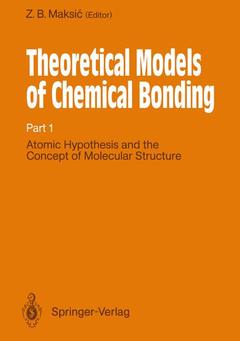Description
Atomic Hypothesis and the Concept of Molecular Structure, Softcover reprint of the original 1st ed. 1990
Tertiary Level Biology Series
Coordinator: Maksic Zvonimir B.
Language: English
Subjects for Atomic Hypothesis and the Concept of Molecular Structure:
Keywords
Molekülphysik; Theoretische Chemie; bonding; chemistry; chirality; iron; structure; theoretical chemistry
Publication date: 11-2013
324 p. · 17x24.2 cm · Paperback
324 p. · 17x24.2 cm · Paperback
Description
/li>Contents
/li>
"Imagination and shrewd guesswork are powerful instruments for acquiring scientific knowledge . . . " 1. H. van't Hoff The last decades have witnessed a rapid growth of quantum chemistry and a tremendous increase in the number of very accurate ab initio calculations of the electronic structure of molecules yielding results of admirable accuracy. This dramatic progress has opened a new stage in the quantum mechanical description of matter at the molecular level. In the first place, highly accurate results provide severe tests of the quantum mecha nics. Secondly, modern quantitative computational ab initio methods can be synergetically combined with various experimen tal techniques thus enabling precise numerical characterization of molecular properties better than ever anticipated earlier. However, the role of theory is not exhausted in disclosing the fundamental laws of Nature and production of ever increasing sets of data of high accuracy. It has to provide additionally a means of systematization, recognition of regularities, and ratio nalization of the myriads of established facts avoiding in this way complete chaos. Additional problems are represented by molecular wavefunctions provided by the modern high-level computational quantum chemistry methods. They involve, in principle, all the information on molecular system, but they are so immensely complex that can not be immediately understood in simple and physically meaningful terms. Both of these aspects, categorization and interpretation, call for conceptual models which should be preferably pictorial, transparent, intuitively appealing and well-founded, being sometimes useful for semi quantitative purposes.
The Concept of Molecular Structure.- Topology and Properties of Molecules.- Symmetry in Molecules.- Chirality of Molecular Structures — Basic Principles and Their Consequences.- Interplay of Experiment and Theory in Determining Molecular Geometries. A. The Experiments.- Interplay of Experiment and Theory in Determining Molecular Geometries. B. Theoretical Methods.- Molecular Mechanics alias Mass Points and Elastic Springs Model of Molecules.- Atoms in Molecular Evironments.- The Modelling of Molecules as Collections of Modified Atoms.
© 2024 LAVOISIER S.A.S.




